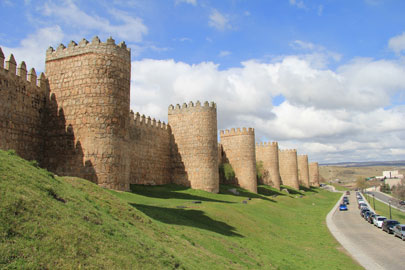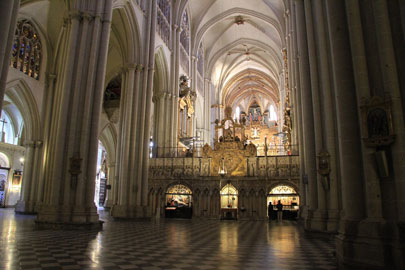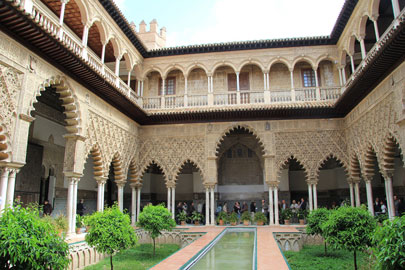SOUTHERN SPAIN:
FROM THE ROMANS TO THE MOORS
FROM THE ROMANS TO THE MOORS

The Alhambra Palace in Granada
|
The softer Andalusian skies Dispelled the sadness and the gloom; There Cadiz by the seaside lies, And Seville's orange-orchards rise, Making the land a paradise Of beauty and of bloom. There Cordova is hidden among The palm, the olive, and the vine; Gem of the South, by poets sung, And in whose Mosque Ahmanzor hung As lamps the bells that once had rung At Compostella's shrine. But over all the rest supreme, The star of stars, the cynosure, The artist's and the poet's theme, The young man's vision, the old man's dream,-- Granada by its winding stream, The city of the Moor! And there the Alhambra still recalls Aladdin's palace of delight; Allah il Allah! through its halls Whispers the fountain as it falls, The Darro darts beneath its walls, The hills with snow are white. |
Ah yes, the hills are white with snow, And cold with blasts that bite and freeze; But in the happy vale below The orange and pomegranate grow, And wafts of air toss to and fro The blossoming almond trees. The Vega cleft by the Xenil, The fascination and allure Of the sweet landscape chains the will; The traveller lingers on the hill, His parted lips are breathing still The last sigh of the Moor. How like a ruin overgrown With flowers that hide the rents of time, Stands now the Past that I have known; Castles in Spain, not built of stone But of white summer clouds, and blown Into this little mist of rhyme! |
Henry Wadsworth Longfellow, 'Castles in Spain'
THE TOUR
The B.C. Archaeology Tour of Southern Spain has an emphasis on the archaeology and history of the region. Our program begins in Madrid where we explore the old quarter. The following day we spend the morning in the newly revamped National Archaeological Museum with its astonishing collection of antiquities. In the afternoon we visit the magnifient 18th Century Royal Palace. From Madrid we head north to the mediaeval town of Segovia, famous for its well preserved Roman aqueduct which extends for over 800 m. We visit the mid-16th Century Cathedral, and the royal castle, known as the Alcazar. We also visit the local Museum which has a fascinating collection of Visigothic artefacts. We then head to Avila where we explore the 11th Century walls of the city, the Cathedral and the beautiful Romanesque basilica of San Vincente.
We head south to the mediaeval city of Toledo, one of the highlights of our trip. We explore the Gothic Cathedral, two mediaeval synagogues, and see the amazing Church of San Roman which was decorated in Muslim style. The Gothic Monastery of San Juan is a breathtaking lace-like building. From Toledo we drive to the small city of Merida. This town was known to the Romans as Augusta Emerita, the capital of the Province of Lusitania. It preserves splendid monuments from the Roman period including: a Roman Bridge, a Temple of Diana, a Roman aqueduct, a theatre and amphitheatre. We also visit the National Museum of Roman Art. From Merida we travel to Italica where we see the impressive Roman amphitheatre, the Roman bath complex and numerous house mosaics. Our next stop is Seville which is our base for four nights. In the old quarter of the city we visit the Cathedral, and explore the fabulous Alcazar of Seville. This was the 14th Century royal palace constructed by Pedro the Cruel and recentlyused as the location of Dorn in �Game of Thrones�. We visit the impressive Plaza de Espana pavilion, and see the Archaeological Museum, which contains a rich collection of artefacts from Roman Italica.
From Seville we head to the port city of Cadiz. The local archaeological museum contains a fascinating collection of Phoenician and Roman artefacts. We then travel along the coast to the ancient Roman site of Baelo Claudia, located close to the beach and within sight of Morocco. This compact site has an impressive forum with four temples and a basilica, as well as a theatre and a number of houses. We then head into the hills of Andalusia, famous for their white washed villages. We spend two nights in the picturesque village of Ronda. This was a Moorish settlement and preserves a wonderful 13th Century bath complex and two minarets. The city is famous for its 18th Century bridge across a deep gorge. The local museum is housed in an old Moorish Palace.
From Ronda we head to Antequerra where we see a number of prehistoric dolmen tombs dating from around 2500 BC. We then head to Cordoba where we see the famous 9th Century mosque (la Mezquita) with its vast forest of 1300 marble columns. We walk over the old Roman Bridge to the Tower of Calahorra, and visit the Alcazar, the Muslim era Palace which was rebuilt in the 15th Century. From Cordoba we visit the 10th Century palace complex of the Caliph Abd el Rahman III at Medinet el-Zahra. This royal city was constructed to house the Caliph and his family, including administrative offices, reception rooms, and wonderful gardens.
We then head south to Granada. A highlight of our visit is the spectacular Alhambra palace complex which incorporates the impressive Alcazaba fortress, the Nasrid Palaces (a collection of lavishly decorated buildings which were erected by various Muslim rulers from 1365 to 1492), the 16th Century Palace of Charles V, and the gardens of the Generalife, the summer palace of the Sultans. We also take a walk through the Albaicin district, a section of the walled town with many historic buildings including a wonderfully preserved Moorish bath complex. In the centre of Granada we see the 16th Century Cathedral and the impressive Royal Chapel.
The tour concludes back in Madrid. Here we spend a morning in the stunning Prado Museum, famous for its medieval and renaissance paintings and sculpture. There is free time in the afternoon for last minute sightseeing and shopping.

The aqueduct of Segovia
ITINERARY*
Day 1: Depart Australia
Our flight on Emirates Airlines leaves Australia with a short stop over (usually 1-2 hours).
Day 2: Arrive Madrid
We arrive into Madrid in the early afternoon and check into our hotel. After freshening up we go for a relaxed walk in the historic quarter. We have some tapas in the Mercado San Miguel. Overnight Madrid.
Day 3: Madrid
In the morning we visit the superb National Archaeological Museum, home to a magnificent collection of ancient artefacts. In the afternoon we see the Royal Palace, a magnificent 18th Century building which preserves a wonderful collection of art and weapons. Overnight Madrid.
Day 4: Segovia
In the morning we travel north to the town of Segovia. Here we see the spectacular 2nd Century Roman aqueduct, the 16th Century Gothic Cathedral and the Alcazar, a 14th Century castle. We also visit the wonderful Museum of Segovia with its excellent collection of artefacts relating to the history of the site. In the afternoon we travel a short distance to Avila, a walled mediaeval village, where we check into our hotel. Overnight Avila.
 |
 |
The mediaeval walls of Avila |
The Cathedral of Toledo |
Day 5: Avila
In the morning we explore the sights of the mediaeval city of Avila. We see the Romanesque and Gothic Cathedral (started in the 12th Century), the impressive medieval city walls and the magnificent 12th Century Romanesque Basilica of San Vincente. In the afternoon we travel south to Toledo where we check into our hotel. Overnight Toledo.
Day 6: Toledo
We spend the day exploring the wonderful sights of mediaeval Toledo. We do a walking tour of the old quarter including: the magnificent Gothic Cathedral (constructed from 1227-1493), the Sinagoga del Transito constructed in 1366 and which includes a museum of Sephardic Jews, the 13th Century Synagogue of Santa Maria la Blanco and the superb 15th Century Monastery of St John. We also see the church of San Roman now a Museum with a fascinating collection of Visigothic artefacts. Overnight Toledo.
Day 7: Merida
In the morning we head south to Merida. Here we visit the beautiful Roman ruins which include a remarkably well preserved theatre and amphitheatre, a 'Temple to Diana' and a Roman bridge. After a siesta we see the National Museum of Roman Art which contains a well displayed collection of Roman sculpture and artefacts from ancient Merida. Overnight Merida.
 |
 |
The Roman theatre of Merida |
The Alcazar of Seville |
Day 8: Italica
We head south of Merida towards Seville stopping to see the ancient ruins of Italica, the first town the Romans established in Iberia. Highlights include the well preserved amphitheatre and a number of house mosaics. We then continue our journey to Seville where we check into our hotel. This will be our base for the next couple of days. Overnight Seville.
Day 9: Seville
In the morning we take a walk in the old quarter of the city where we visit the remarkable 15th Century Cathedral and climb the Giralda Tower. This was originally the minaret of the Muslim Mosque which was later converted into the Cathedral bell-tower. The afternoon is set aside for rest and relaxation. We see a flamenco performance in the evening. Overnight Seville.
Day 10: Seville
Today we visit the Plaza de Espana where we see the Pavilion built for the Spanish American Fair in the 1920s and take a walk in the beautiful Park of Maria Luisa. We then visit the Seville Archaeological Museum. This contains a magnificent collection of artefacts from Roman Italica as well as material from other nearby sites. The afternoon is devoted to the superb Alcazares Reales, the 14th Century royal palace complex and gardens of Seville. A highlight is the Moorish rooms of the palace of Pedro I. Overnight Seville.
Day 11: Seville
The day is set aside as free time in Seville. It is possible to explore the many historical and cultural sites of the city or simply have a rest.
Day 12: Cadiz
In the morning we head south to the city of Cadiz located on the Atlantic coast. In the afternoon we visit the archaeological Museum with its superb collection of Roman and Phoenician antiquities including two Phoenician coffins. We also see the remarkable 18th Century Baroque Catedral Nueva. Overnight Cadiz.
Day 13: Baelo Claudia
In the morning we head east along the coast to visit the Roman ruins of Bolonia, the ancient city of Baelo Claudia. Here we see the remains of some of the ancient houses, the civic Forum with remains of three Roman temples, the market place and ancient theatre. There is also a small on site museum with artefacts of daily life. We continue on our way, staying overnight in the scenic hill town of Ronda. Overnight Ronda.
 |
 |
The Roman ruins of Baelo Claudia |
The hill town of Ronda |
Day 14: Ronda
The day is set aside to explore the majestically located hill town of Ronda, one of the most famous of the 'White Towns' of Andalusia. The city is spectacularly located on the edge of the steep Tajo gorge which runs through the centre of the old quarter. On our walk we see the magnificent 18th Century Bridge, as well as the old Moorish quarter including the city walls and mediaeval Arab baths. Overnight Ronda.
Day 15: Antequera - Cordoba
In the morning we head north-east to Cordoba. En route we stop to see the remarkable megalithic dolmens at Antequera, some of Spain's oldest monuments. Built in the time of the pyramids, these stone tombs are a marvel of ancient engineering. We arrive into Cordoba in the early afternoon and after checking into our hotel we visit the Alcazar gardens. We then see a performance of the Royal Cavaliers who are famous for their horsemanship. Overnight Cordoba.
Day 16: Cordoba
The morning is set aside for an exploration of the remarkable Mezquita complex, the heart of ancient Cordoba. One of the largest mosques in the Islamic world, it is a highlight of Spain�s Moorish architecture. Deep inside the mosque, almost overlooked, is a 16th Century Renaissance Cathedral. In the afternoon we explore the Roman Bridge and Tower of Calahorra. There is free time to relax or explore more of the old quarter. Overnight Cordoba.
Day 17: Medina Az-Zahara
Today we visit the ruins of Medina Az-Zahara which lie 8km west of Cordoba. This Moorish palatial complex was built over three terraces and was surrounded by an enormous defensive wall. A highlight of the complex includes the superb Dar al Mulk palace set in extensive gardens. In the afternoon we travel SE to the city of Granada.
 |
 |
The Mezquita of Cordoba |
The Generalife gardens of the Alhambra palace |
Day 18: Granada
The morning is spent exploring more of the splendid Gothic buildings of Granada. We start with the 16th Century Renaissance Cathedral and see the superb Royal Chapel commissioned by Isabella and Ferdinand to be their tomb. In the afternoon we explore Granada's Albacin quarter by foot including an impressive 11th Century Arab bath complex. There are stunning views to the Alhambra from the local viewing points. Overnight Granada.
Day 19: Alhambra and Generalife
Today we visit the superb Alhambra palace complex, one of the great Moorish sites in Spain. The Nasrid Palaces, with their recently restored 13th Century plaster work and tiles, are a highlight but we also see the Alcazaba fort and palace of Charles V. In the early afternoon we see the nearby Generalife Gardens with their elegant fountains and floral displays. Overnight Granada.
Day 20: Madrid
We fly to Madrid in the early morning and check into our hotel. In the afternoon we visit the magnificent Prado Museum which has a stunning collection of medieval and renaissance paintings and sculpture. In the afternoon there is some free time for last minute shopping. Overnight Madrid.
Day 21: Fly to Australia
In the morning we head to Madrid International Airport for our flight to Australia. There is a brief stopover en route.
Day 22: Arrive Australia
We arrive back in Australia in the evening.
*Please note that the itinerary is subject to minor change..

